Thursday, August 31, 2017
Where to Find VR at PAX West 2017
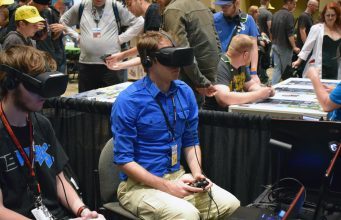
The Penny Arcade Expo (PAX) will be back in its hometown of Seattle this September 1st through 4th and Road to VR has again done the heavy lifting of sorting out all the VR things to see at this year’s convention:
| Exhibitor | Exhibit | Platforms | Location |
| Alienware | (TBD) | Oculus | #1115 |
| Anshar Studios | Detached | Oculus, Vive | #6003 |
| Archiact VR | (TBD) | (TBD) | Westin Hotel, 4th Floor |
| Bethesda Softworks | Doom, Skyrim, Fallout 4 | Oculus, PSVR, Vive | #1102 |
| BigBox VR | Smashbox Arena | Oculus, PSVR, Vive | Westin Hotel, 4th Floor |
| Cyan Inc | Obduction | Oculus, PSVR, Vive | #857 |
| Dell | (TBD) | Windows Mixed Reality | #1125 |
| Drifter Entertainment | Gunheart | Oculus, Vive | Grand Hyatt |
| Emerald Beast | Sellsword VR | Oculus, Vive | Westin Hotel, 4th Floor |
| Fantom Fathom | Perch | Oculus, Vive | Westin Hotel, 4th Floor |
| Gattai Games | Stifled | Oculus, OSVR, PSVR, Vive | #862 |
| Gene Games | (TBD) | (TBD) | Westin Hotel, 4th Floor |
| Kite and Lightning | Bebylon Battle Royale | Oculus, Vive | Westin Hotel, 4th Floor |
| NullSpace VR | Hardlight VR Suit | PC | Westin Hotel, 4th Floor |
| Oasis Games | Light Tracer | PSVR | #6808 |
| Oculus | (Multiple games) | Oculus | Westin Hotel, 4th Floor |
| PlayStation | (TBD) | PSVR | #100, #103, #109, #203, #209 |
| Secret Location | Blasters of the Universe | Oculus, Vive | #844 |
| Smidgen Softworks | How May I Haunt You | Oculus | 3rd Floor Annex |
| Spontaneous Quirk | Aden’s Musical Playground | Oculus | Westin Hotel, 4th Floor |
| Square Enix | Monster of the Deep: Final Fantasy XV | PSVR | Sheraton Hotel, Aspen Room |
| Surprise Attack Games | Blind | Oculus, OSVR, PSVR, Vive | #6312 |
| Think On Labs | Ship It | Oculus, Vive | #7317 |
| TN Games | PhantomSense | PC | Westin Hotel, 4th Floor |
In addition to the expo halls, PAX West will again have a VR freeplay area along with multiple tournaments throughout the 4-day event. There will also be many VR-themed panels and developer discussions (including one moderated by Road to VR).
Cell reception can be spotty in the packed Washington State Convention Center, so attendees may want to download the official PAX West 2017 guidebook (and a copy of this article) ahead of time.
The post Where to Find VR at PAX West 2017 appeared first on Road to VR.
Ream more: https://www.roadtovr.com/where-to-find-vr-at-pax-west-2017-virtual-reality/
SUPERMARKET VIOLENCE | Shooty Fruity (Oculus Rift VR Gameplay)
Please subscribe. Also, check out my Virtual Reality articles and opinions on http://www.ukrifter.com - want to contribute articles? Contact me. Got an opinion? Contact me on Twitter @UKRift, or on Facebook - https://www.facebook.com/ukrifter -= If you want to help me out I would be hugely grateful if you could share this video with =- -= your friends & family via the usual social media sites: twitter, facebook, reddit, etc. =- **Voice Acting** - I currently offer FREE voice acting for VR projects. @@ Email address: ukrifter (at) gmail (dot) c0m @@ If you want to buy me a Beer / Lamborghini, then paypal to the same email address. == Who the devil are you Sir? == Typically I play with VR on my weekends and schedule video posts through the week. I invest my own money in order to review, compare and contrast. I run this for the love of the technology, I am NEVER paid for my opinion, and as a result my opinions will remain unbiased, however, as I tend to praise in public and feedback negative experiences privately to developers, I rarely review a bad title. Not seen something reviewed here, maybe you have your answer. == Special Thanks == UKRifter Logo by Jo Baker Freelance Design - http://jobaker.co.uk/ == Techno Babble for the Geeks == HMD: HTC Vive, Oculus Rift DK1 / DK2 / CV1 CPU: i7 4790K GPU: Nvidia EVGA 1080 SC edition RAM: 16GB Storage: SSD / Hybid SSD Screen recorder: OBS Wheel: Logitech G27 Joystick: Thrustmaster T-Flight HOTAS X Mouse: RAT 7 == Legal == The thoughts and opinions expressed by UKRifter and other contributors are those of the individual contributors alone and do not necessarily reflect the views of their employers, sponsors, family members, pets or voices in their heads. == Audio Credits == UKRifter Jingle by Christopher Gray Licensed under Creative Commons: By Attribution 3.0 http://creativecommons.org/licenses/by/3.0/ You can also donate via Streamlabs https://youtube.streamlabs.com/theukrifter#/
Otoy Wants to Make Light-field Rendering Affordable with a Supercomputing Cluster You Get Paid to Be Part Of

Otoy has announced the Render Token, a blockchain-based currency that underpins a distributed GPU rendering network. The company hopes to allow idle GPUs on consumer PCs to be tapped for rendering work, earning money for the owner in exchange for their computer’s work. The goal, Otoy says, is to make massive GPU rendering power available at low cost for rendering light-fields and more.
Otoy is a maker of rendering tools and a proponent of light-fields as the next-generation format of capture and display for AR and VR. Light-fields can be thought of as volumetric representations of a scene, where every view possible has already been calculated, allowing for real-time playback of cinema-quality scenery, even in demanding applications like virtual reality. Sounds great, right?
One problem with the practical application of light-fields is that they’re expensive to render, both computationally and temporally. If you want to farm your render out to the cloud to get it done in a reasonable amount of time, you can expect to pay a hefty fee.
For a company that’s pushing light-field as the future of immersive content, that rendering cost is a major blocker to adoption. And so on a quest to make GPU rendering dramatically more affordable, Otoy is mashing up the ideas of distributed supercomputing clusters and the blockchain with the hopes of creating a decentralized cloud rendering network that runs rendering tasks on idle GPUs in exchange for payment in the form of a cryptocurrency.
Introducing Render Token
The result is what Otoy calls the Render Token (RNDR). It’s a cryptocurrency coin based on the Ethereum blockchain, and the company says it’s the payment that will be used to incentivize and compensate participants in the rendering network for the use of their GPU power.
Distributed Computing Isn’t Exactly New
The idea of a distributed computing supercomputing cluster isn’t new. You may have heard of Folding@home or SETI@home, two popular distributed computing initiatives which borrowed unused computational power from idle computers running a piece of client software. But that computation power was offered by users on a volunteer basis. Now that blockchain technology (the underlying structure of cryptocurrencies) has been proven out, there’s a trusted method to distribute payments among a network of computers performing work for paying customers.
Intrinsic Human Value
Typical cryptocurrencies work by incentivising so-called ‘miners’ to run software on their computers to log and process cryptocurrency transactions for the whole network, and in exchange receive small bits of the cryptocurrency for their work. But all that processing power spent on number crunching is wasted, argues Otoy CEO Jules Urbach in his introduction of RNDR.
GPU hashing [AKA mining] incurs real world energy and cap-ex costs which return less and less value to the crypto-community as the blockchain grows. Over time, and on a global scale, this becomes enormously wasteful as GPU compute cycles are essentially thrown away hashing numbers with no intrinsic human value, while GPU rendering power on AWS remains scarce at $14.4/hour ( ~1000 OctaneBench).
Instead, Urbach says, the fundamental mining work that underpins crytocurenies could be used to produce valuable output in the form of rendered imagery.
The Render Token recalibrates the weighting of GPUs in the network, making it possible for each transaction on the blockchain to validate far greater value of equivalent GPU proof-of-render work that is valuable for real world jobs that are prohibitively expensive to fulfill quickly on local or centralized GPUs.
ICO Incoming
If you’re at all familiar with cryptocurrencies, you’ll know where this is all heading… an ICO. Otoy plans to make an ‘Initial Coin Offering’, which is a sale of the first Render Tokens. It’s both a way for Otoy to raise capital for their initiative and to establish the initial value of each Render Token. The company will offer a limited number of tokens, and, according to the Render Token White Paper, hopes to sell $134 million to support the project, presumably cutting off the supply after that amount is raised. That wouldn’t be the largest ICO to date (that would be Filecoin at $250M+, according to The Cointelegraph), but it’s not far off. Here’s how Otoy says they’ll spend the funds:
40% – will go to future development of each expansion phase (I-IV) and will support the team dedicated to the operations and engineering of the Render Token platform.
25% – running, maintaining, and scaling the network – this will include developing and creating new and more efficient solutions for rendering through custom built GPU solutions, effectively lowering the price of rendering across the network and the world.
20% – will be allocated to marketing and expanding the applications and reach and use-cases of the network.
10% – for third party services and contractors providing guidance and efficiencies to the project.
5% – for unforeseen roadblocks and circumstances.
Buying (or selling) Rendering Power
Owners of Render Tokens can then be spent to pay for rendering work on the network, or sold to others in exchange for difference currencies. Their ultimate value will be determined over time by the market, with prospective purchasers hoping value will increase following the ICO.
More Than Light-fields
Light-fields are particularly compelling for AR and VR, and Otoy hopes that the Render Token platform will make rendering them faster and more affordable, but light-field isn’t the only thing that the system can render; the company points to the following categories that could be disrupted if they achieve their vision of affordable, distributed rendering:
Media – From blockbuster films to home movies, RNDR brings affordable GPU compute to democratize advanced special effects and graphics. This will accelerate the arrival of holographic displays and avatars to change storytelling forever.
Gaming – Billions of consumers worldwide put unprecedented demands on 3D game engines. RNDR will provide the infrastructure and standards to uplevel gaming and finally bring cinematic rendering to interactive experiences.
Manufacturing – RNDR makes scientific-grade rendering available to any 3D object. Industry will be retooled as physics-accurate rendering transforms imaging from 3D visualization to intelligent 3D simulation.
Medical – Radiology is being overhauled by the introduction of high-level rendering. From surgeons to new medical students, RNDR will enable unprecedented levels of fidelity in medical imaging at a fraction of the speed and cost.
Virtual Reality – RNDR will bring economical light field media and streaming to allow any artist to create high quality VR experiences at 72K resolution and beyond —rendering an immersive Metaverse in stunning detail.
Augmented Reality – As the ARKit and ARCore revolutions take off, RNDR will make photorealistic objects and scenes on wearables and mobile devices a possibility by democratizing the authorship, registration and streaming of light fields and next gen media formats.
Mixed Reality – With the breakout successes of WeChat and SnapChat, the economy of virtual goods and services is only just beginning. RNDR will provide the key distribution system to monetize and track and digital objects in the Metaverse.
The post Otoy Wants to Make Light-field Rendering Affordable with a Supercomputing Cluster You Get Paid to Be Part Of appeared first on Road to VR.
Ream more: https://www.roadtovr.com/otoy-render-token-rndr-light-field-vr-ar/
Wednesday, August 30, 2017
ORANGE IS THE NEW BLACK IN VR | Prison Boss VR (HTC Vive Gameplay)
Prison break? No way! You want to become the Prison Boss by helping inmates in need. Make money by crafting things that are highly popular in prison, things like cigarettes and erotic novels... As always at the end of the video we let you know what we think of the game! Subscribe for more VR → https://www.youtube.com/c/caschary?sub_confirmation=1 In this HTC Vive gameplay video we play Prison Boss VR where you are an inmate. Much like Orange Is The New Black, but in Virtual Reality. You are a prisoner and you have to work yourself up by crafting and trading what your inmates need. The harder you work, the more money and reputation you gain. With that, you are able to have much more freedom - like adding nice furniture in your jail room. This is not like Prison Break or The Escapists where they try to escape, no you are trying to make a business and become the Boss of the Prison. Are you ready for this prison simulator? ► Get Prison Boss VR here → http://store.steampowered.com/app/673600/Prison_Boss_VR/ [Steam Description] Prison Boss VR is a crafting and trading game using room-scale to turn your VR space into a jail cell! Craft cigarettes, alcohol and cookies for other inmates! Customize your cell as your reputation grows! Earn cash until you can’t store it anymore and become the Prison Boss! More HTC Vive gameplays and reviews → https://www.youtube.com/watch?v=RYl0nceTmYU&list=PL86GNGPnZ0siwDr9AoFLro8NF4CnAqSYx ► Like what we do? → https://www.patreon.com/casandchary ► Twitter → https://twitter.com/CasandChary ► Instagram → https://www.instagram.com/casandchary ► Facebook → https://www.facebook.com/casandchary ► Discord → https://discord.gg/YH52W2k A special thanks to our Patreon SUPERHEROES for their amazing support ❤: - Daniel L. Much love, Cas and Chary VR #PrisonBoss #VR #VirtualReality #OculusRift #HTCVive
HELL'S KITCHEN VIRTUAL REALITY CHEF - MAKING GORDON RAMSAY MAD! | ChefU VR HTC Vive Gameplay
Let's become a Chef in Virtual Reality on HTC Vive, cooking food in a VR Hell's Kitchen together with a mad Gordon Ramsay. ChefU is a VR Chef simulator built for an immersive Virtual Reality food cooking experience supporting HTC Vive and Oculus Rift headsets. Today I'm jumping into a VR kitchen playing ChefU, becoming a Virtual Reality Chef and learning how to cook and master more than sixty different dishes with dozens of kitchen tools. In this capture, Gordon Ramsay is artificially joining and judging my messy journey through the first dishes to master! This ChefU gameplay in VR on HTC Vive takes you through the first levels in our Virtual Reality kitchen simulator, where I learn to master the oven, the pan and other for me unknown kitchen tools ;) Despite the major glitches in ChefU, I actually enjoyed it a lot and if you are interested, you can find the latest release of ChefU on Steam: http://store.steampowered.com/app/680640/ChefU/ Stay tuned for loads of VR gameplay's and Virtual Reality content coming up on SweViver, probably already tomorrow. Huge thanks for watching my ChefU gameplay, subscribe if you still haven't and hit that Like button if you enjoyed this video! Subscribe SweViver: https://www.youtube.com/SweViver Twitter: https://twitter.com/SweViver Patreon: https://www.patreon.com/sweviver Enjoy Virtual Reality, grab ChefU if you got the chance and cya probably tomorrow again! #HellsKitchen #VirtualReality #GordonRamsay #ChefU #HTCVive #VR #OculusRift
Developer Shows Microsoft’s VR Controllers in Action
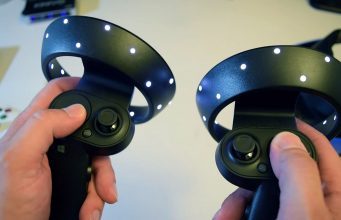
Earlier this week we shared our first hands-on with Microsoft’s VR controllers, but at the time the company didn’t allow us to document the session with photos or videos. Now, a developer with the controllers has produced a handy overview that shows how they work and gives a glimpse of them in action.
The Windows “Mixed Reality” (Microsoft’s term for AR and VR) controllers are unique among similar VR controllers (like those of the Rift and Vive) because they don’t require external sensor for motion tracking. Instead they are tracked by cameras on the VR headset (as far as we know, all of the Windows VR headsets will support the controllers). That means that setup is simplified, but also comes with a crucial downside which is that the controllers lose their positional tracking when outside of the camera’s view for more than a second or two.
Developer Sean Ong demonstrates this, while overviewing the controllers, by placing a bag over the tracking markers to block them from the camera’s view. When that happens the positional tracking is lost but the controller continues to reflect proper rotation thanks to internal rotation sensors. When the controller comes back into view of the camera, they pop back into place and regain positional tracking.
For many VR games and applications this limitation not even be noticeable, especially because Microsoft is doing a bit of prediction to compensate for brief moments of positional tracking loss, though it could impact the experience for some apps where players frequently have their hands outside of the camera’s field of view.
Otherwise, Ong’s experience matches my own thoughts after a hands-on with the controllers: the placement of the trackpad and thumbstick is a little strange, and while the tracking may have some limitations, it’s definitely functional.
The post Developer Shows Microsoft’s VR Controllers in Action appeared first on Road to VR.
Ream more: https://www.roadtovr.com/microsoft-windows-mixed-reality-controllers-vr-hands-on-video/
5 Google ARCore Experiments That Inject Magic into Everyday Life
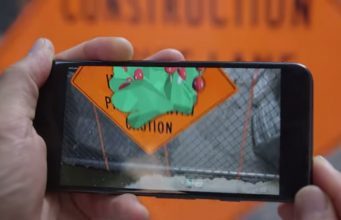
Google released a preview version of ARCore for Android yesterday, the company’s answer to Apple’s ARKit. Since ARKit was released a few months ago, we’ve seen a bevy of really cool experiments and potential apps to come from developers from all over the world, but now it’s ARCore’s turn to shine.
Developers looking to use ARCore to create augmented reality apps can start building right now on both the Pixel line and Samsung S8 line. The platform will be targeting 100 million devices by the end of preview access however, coming from various hardware manufacturers and potentially making ARCore the defacto largest AR platform when it launches on other devices later this year.
While the critical mass of inspiring (and hopefully useful) ARCore apps has probably yet to come, here are some cool early experiments that get us excited about the potential of AR to inject something magical into every day life.
Morph Face
Morph Face is an experiment that lets you morph any surface around you into a new shape. It uses shaders to achieve the morphing effect.
Built by George Michael Brower with friends at Google Creative Lab. Built with Unity and ARCore.
Portal Painter
Portal Painter gives you a fun way to create portals into other dimensions. Just point your device at a nearby surface, then use your finger to paint a portal into another world.
Built by Jane Friedhoff with friends at Google Creative Lab using Unity and ARCore.
Hidden World
Hidden World is a simple experiment that combines hand-drawn animation with augmented reality. Point your device at the ground, then tap anywhere to reveal an animated world at your feet.
Built by Rachel Park Goto and Jane Friedhoff with friends at Google Creative Lab using Unity and ARCore.
Draw and Dance
Draw and Dance lets you create your very own dancing AR stick figure that reacts to the music and sound around it – your voice, your dog’s bark, and best of all, your playlist. This character can also augment your Google Home by taking its place on top of the speaker and moving in response to whatever sound comes out.
Built by Judith Amores Fernandez and Anna Fusté Lleixà with friends at the Google Creative Lab using Unity, ARCore, Vuforia and API.AI
ARCore Drawing
This is a simple demo that lets you draw lines in 3d space. It was made as a quick example of how to combine openFrameworks and ARCore. You can get the source code here.
Built by Jonas Jongejan using openFrameworks and ARCore.
Keep an eye on Google’s AR Experiments page for more in the coming weeks.
The post 5 Google ARCore Experiments That Inject Magic into Everyday Life appeared first on Road to VR.
Ream more: https://www.roadtovr.com/5-google-arcore-experiments-inject-magic-everyday-life/
‘Star Trek: Bridge Crew’ 50% Off on Steam Until September 5th

Ubisoft’s latest and greatest entry into VR, Star Trek: Bridge Crew (2017), is currently on sale for $25, exactly half the price since its launch back in late May.
As a crew member aboard the U.S.S. Aegis, a ship created for the game styled after the J.J. Abrams reboot, it’s your job to fill one of 4 roles as you clash with Klingon ships on the wrong side of the Neutral Zone. You can fly alone and hop into each role on the fly, with IBM’s Watson assisting you along the way, or you can play as it was meant to be experienced—with Trek fans across all supported devices including PSVR, Oculus Rift and HTC Vive.
‘Star Trek: Bridge Crew’ on Steam
The Steam version of the game works on both HTC Vive and Oculus Rift, and has the added benefit of providing a mutual friends list so you can team up with your buddies regardless of whether they own a Rift or Vive.
It’s an exceptionally immersive experience captaining the Aegis with real people at your side. See why we gave this social VR co-op game a solid [9/10] in our review.
The post ‘Star Trek: Bridge Crew’ 50% Off on Steam Until September 5th appeared first on Road to VR.
Ream more: https://www.roadtovr.com/star-trek-bridge-crew-50-off-steam-september-5th/
Tuesday, August 29, 2017
‘Windlands’ Currently 75% Off on Steam, Sale Ends September 4th
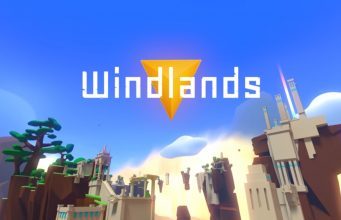
Windlands (2016) is a first-person exploration game from Psytech Games, and as one of the first truly great titles to come to all major VR headsets, the temporary $5 price tag on Steam—down from its normal $20—is an absolute steal for what it offers.
After generating over $20k in a successful Indiegogo campaign in fall of 2014 and subsequently being Greenlit on Steam, Windlands is out of early access and available on every major headset including Oculus Rift, HTC Vive, OSVR and PSVR.
The Steam version however is only compatible with HTC Vive, Oculus Rift and OSVR, and can be played with motion controllers or gamepad. The Oculus Store version, which only offers support for Rift, is still advertising the full $20 price tag.
You can’t help but marvel at the grandiosity of the environment Windlands creates. Offering a calming, zen-like atmosphere with increasingly difficult terrain, you’ll easily lose a few hours to trying to figure out just how to get that last Easter egg before you move on to the next level.
The main means of locomotion: your trusty grappling hook that lets you soar through the ruins of a fallen civilization and discover the secrets of the ancient world. The game also works on traditional monitors (but we’re not sure why you’d ever want to).
The post ‘Windlands’ Currently 75% Off on Steam, Sale Ends September 4th appeared first on Road to VR.
from https://www.roadtovr.com/windlands-currently-75-off-steam-september-4th/
‘Sparc’, the 1v1 VR Sport From CCP Games, Launches Today on PSVR
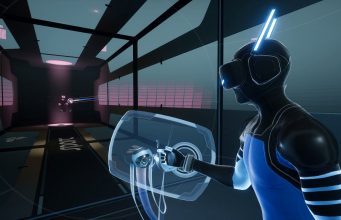
Originally starting its life as an experimental VR project called ‘Project Arena’, the competitive-focused VR sport Sparc launches today on PSVR.
Update (8/29/17): Sparc launches today on PSVR priced at $30 / €30 / £23. Because the game is primarily focused on 1v1 multiplayer gameplay, there was no online population available ahead of the game’s release for us to clock enough game time for a full review. After a pre-release game session with one of the game’s developers, however, we have some hands-on thoughts to share.
Sparc is primarily a multiplayer game, though it does feature a series of challenge modes which have leaderboards for those seeking a high score. The core of the game involves two players facing each other at opposite ends of a corridor. Each player has a glowing ball which they throw at the opposing player with the hopes of hitting the opponent’s body to score a point. The opponent can dodge out of the way of the incoming ball, or use their deflector shield (only available when grasping their own ball) to bat the ball away. The deflector shield is useful but depletes after one hit from the opponent’s ball. You’ll need to throw your ball toward the opponent and have it return in order to revive the shield.
As you can imagine, with PSVR’s less-than-stellar tracking, having your tracking camera setup just right is important to success in Sparc; you’ll want to make sure your arms don’t exit the tracking volume when at their maximum extension in all directions. It wasn’t until I tweaked my own setup (and a fair amount of practice) that I felt like I was able to achieve reasonably accurate throws. CCP has lathered on a fair amount of aim assist to help with this (though it is reduced in the ‘Advanced’ game mode which is designed for greater levels of competition).
Aside from throwing glowing balls at your opponent and hoping to score a hit, Sparc offers players a fairly customizable avatar in a surprisingly functional configuration interface. You’ll be able to outfit your futuristic-looking avatar with different colored skins, jerseys, hairstyles, eye glasses, face-masks, and more, and many of the items can be colorized to your desire. The result is suitably futuristic and fit looking avatars that feel right at home in this sci-fi VR sport.
For a multiplayer-focused game, keeping players coming back for more is hugely important to the game’s success. It will take more hands-on time to determine if Sparc has the competitive allure to draw folks back in after the game’s initial novelty wears off.
Sparc is PSVR exclusive for now, but the developers say they’ll be talking about additional platform support later this year. That could mean that the game will find its way to the Rift and Vive (after all, CCP’s Eve Valkyrie is one of our top recommended multiplayer VR games with crossplay support), though it isn’t clear if the improved tracking of the Rift and Vive would lead to too significant of an advantage that PSVR players would need to stay in a league with their own kind.
Update (07/26/17): CCP today revealed in a Sony blogpost that Sparc will be launching on PSVR August 29th. Before launch, the studio plans on teasing more character customization as well as taking a build to Gamescom where they’ll be demoing Sparc’s single-player challenges, a series of timed events that test throwing and deflection accuracy in an environment designed to improve skills and help prepare players for human opponents.
Original Article (06/13/17): Developers CCP Games, famous for the persistent MMORPG Eve Online, have been at the forefront of VR development for several years, creating the successful VR spin-off titles Eve: Valkyrie and Gunjack. Sparc is the company’s first non-Eve universe title, being presented as an entirely separate, VR sports game.
Once known as Project Arena, the game is the result of early experimentation with VR motion control from CCP’s Atlanta studio. The prototype was already in very impressive shape during my hands-on at Eve Fanfest 2016; its particular style of energetic action combined with spectator features struck me as a great candidate for a true VR sports game.
When the project reemerged as Sparc, it had embraced the sports angle in its design aesthetic, with more tangible ball projectiles rather than discs, and the robotic avatars had received an athletic makeover. Now that the game is nearing launch, CCP is pushing this angle further, coining the term ‘vSport’, and claiming to be the ‘first-of-its-kind, full-body virtual sport’.



The spectator feature has been retained, which acts as a free-form social area to queue up for the next match, and to watch the action ‘courtside’. According to the E3 press release, the game will include “multiple two-player game modes as well as a selection of single-player challenges and training modes, plus a wide range of visually striking customization and personalization options for competitors.”
At our hands-on at GDC 2017, and at this year’s Eve Fanfest, the game was still being discussed as a multi-platform title, due to launch on Vive, Rift and PSVR in 2017, so there must have been a recent decision to introduce a period of timed exclusivity for PSVR. It’s unclear how long this exclusivity will last, but it sounds like PC VR gamers will have to wait until 2018 to play Sparc.
“With Sparc, we’ve set out to deliver an original sport for the current generation of VR hardware,” said Morgan Godat, executive producer at CCP Games’ Atlanta studio. “We want to create plasma-clad sporting champions in living rooms via the virtual court, where challengers will meet and compete with other players from around the world.”
The post ‘Sparc’, the 1v1 VR Sport From CCP Games, Launches Today on PSVR appeared first on Road to VR.
from https://www.roadtovr.com/ccp-games-sparc-to-launch-exclusively-on-playstation-vr-this-year/
Monday, August 28, 2017
PLAY ALIEN ISOLATION ON HTC VIVE IN VIRTUAL REALITY! | New VR MOD Update with Vive Support
New blog about VR gaming
In short current-gen VR is a bit of a mixed bag, but it can be very impressive and seems you be rapidly getting better.
At $600K, Tundra Tracker Smashes Kickstarter Goal in Less Than 24 Hours
Tundra Tracker, the SteamVR Tracking tracker in development by Tundra Labs, has well exceeded its $250,000 Kickstarter goal in less than 2...
-
DOOM 3 VR Edition launches today on PlayStation consoles, bringing the 2004 classic horror-shooter to PSVR for the first time. We haven...
-
Tundra Tracker, the SteamVR Tracking tracker in development by Tundra Labs, has well exceeded its $250,000 Kickstarter goal in less than 2...
-
In Dreams, you can create your own worlds or play those of others, and there are some INCREDIBLE worlds out there. VR mode was just relea...